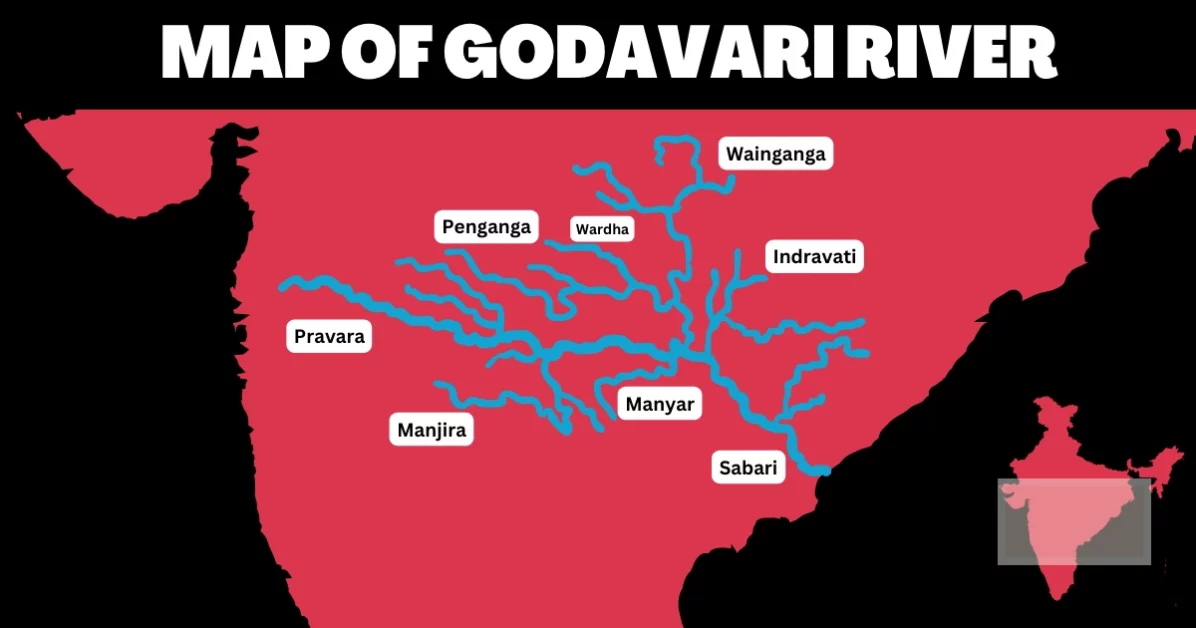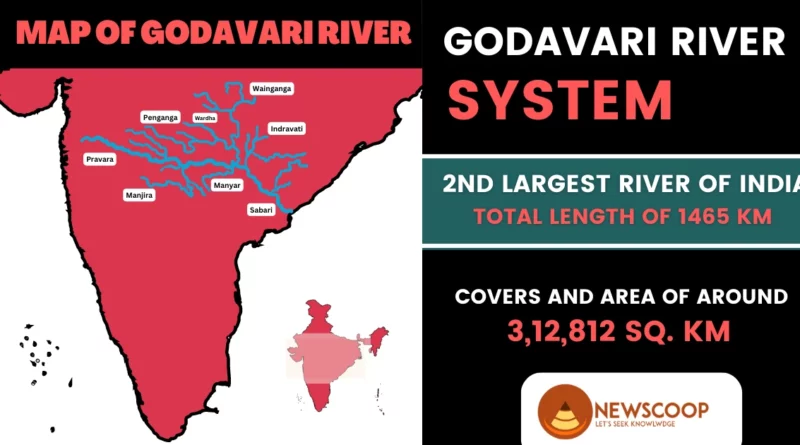Godavari River System: Map, Origin & Tributaries
The Godavari River is an important river in India that has a rich history, cultural importance, and geographical significance. It is a topic that UPSC exam aspirants find fascinating because it provides insights into various aspects of India’s society, economy, and environment.
In this article, we will explore different aspects of the Godavari River, such as its physical features, religious importance, historical significance, and economic impact. Whether you are preparing for the UPSC exam or simply interested in expanding your knowledge, this comprehensive guide will provide you with essential information about the Godavari River.
Geographical Features of the Godavari River
The Godavari River, also called the ‘Dakshina Ganga or Vridha Ganga,’ is the biggest river in peninsular India, similar to the Ganges in the north. Its basin is the second largest after the Ganges basin and covers around 9.50% of India’s total land area.
- The Godavari River originates from Brahmagiri Hill near Trimbakeshwar in Maharashtra.
- It flows through Maharashtra, Telangana, Andhra Pradesh, and Odisha.
- The river covers a significant distance, passing through diverse landscapes including hills, plains, and deltas.
- It is the second-longest river in India, with a total length of about 1,465 kilometers.
- The River has a large catchment area, spreading across several states and covering approximately 312,812 square kilometers.
- It has numerous tributaries, including the Pranhita, Manjira, Sabari, Indravati, and Pench rivers, among others.
- Annual rainfall in the basin ranges from 1,000 to 3,000 millimeters.
- It forms the famous Dowleswaram Barrage near Rajahmundry, Andhra Pradesh, which regulates the river flow and prevents saltwater intrusion.
- The river eventually merges with the Bay of Bengal, creating a vast delta region known as the Godavari Delta.
- The Godavari Delta is one of the largest and most fertile deltas in India, supporting extensive agriculture and rice cultivation.
Geographical Boundaries of Basin
- North: Satmala Hills, Ajanta range, Mahadeo Hills.
- South and East: Eastern Ghats.
- West: Western Ghats.
Distribution of Area
The Godavari River basin covers an extensive area of 312,812 square kilometers. The basin encompasses multiple states, with the following percentages of the basin area falling within each state:
- Maharashtra: 48.6%
- Andhra Pradesh: 23.4%
- Madhya Pradesh: 10.0%
- Chhattisgarh: 10.9%
- Odisha: 5.7%
- Karnataka: 1.4%
Map of Godavari River

Origin & Source of Godavari River
The Godavari River originates from Brahmagiri Hill, located near Trimbakeshwar in Maharashtra, India. This hill serves as the source of the river, and from there, the Godavari flows through various states, including Maharashtra, Telangana, Andhra Pradesh, and Odisha.
What is the Course of the Godavari River?
The Godavari River follows a diverse and extensive course, traversing through multiple states in India. Originating from Brahmagiri Hill near Trimbakeshwar in Maharashtra, the river begins its journey. It flows through Maharashtra, passing through districts such as Nashik, Ahmednagar, and Nanded, before entering the state of Telangana.
As it enters Telangana, the river continues its course, meandering through districts like Karimnagar, Warangal, and Khammam. Along the way, it receives the waters of various tributaries, including the Pranahita and Manair rivers. Notably, the Sri Ram Sagar Project, also known as Pochampadu Dam, is constructed on the river in Telangana, serving multiple purposes such as irrigation and water regulation.
After crossing Telangana, the Godavari River enters the state of Andhra Pradesh, where it flows through East Godavari and West Godavari districts. It forms the renowned Dowleswaram Barrage near Rajahmundry, which aids in controlling the river’s flow and preventing the intrusion of saltwater. The river then continues its journey towards the Bay of Bengal, carrying its precious waters and sediments.
Finally, it enters Odisha, flowing through the picturesque Malkangiri district. It forms the border between Odisha and Chhattisgarh while merging with the Sabari River. Eventually, it gracefully joins the Bay of Bengal, marking the culmination of its extensive and eventful course.
Sub-Basin of Godavari River
Sub-basin refers to a smaller division or subset of a larger river basin. Here is a consolidated list of the sub-basins of the Godavari River, identified by the Krishna-Godavari Commission:
- Upper Godavari (G-1)
- Pravara (G-2)
- Purna (G-3)
- Manjira (G-4)
- Middle Godavari (G-5)
- Maner (G-6)
- Penganga (G-7)
- Wardha (G-8)
- Pranahita (G-9)
- Lower Godavari (G-10)
- Indravati (G-11)
- Sabari (G-12)
Tributaries of Godavari River
The Godavari River, being a major river in India, receives significant contributions from various tributaries. The Pranhita River, the largest among them, covers about 34.87% of the drainage area, making it a crucial source of water for the Godavari. On the right bank, tributaries like Pravara, Manjira, and Maner contribute approximately 16.14% of the basin’s coverage.
On the left bank, important tributaries such as Indravathi, Purna, Pranhita, and Sabari together account for nearly 59.7% of the total catchment area. The remaining 24.16% of the basin’s coverage is made up of the Godavari River itself in its upper, middle, and lower reaches.
Left Bank Tributaries
- Wainganga
- Wardha
- Kadva
- Penganga
- Purna
- Kadam
- Pranahita
- Indravati
- Sabari
- Darna
Right Bank Tributaries
- Pravara
- Mula
- Manjra
- Peddavagu
- Maner
Dams on the Godavari River
Here is a list of some major dams on the Godavari River:
- Godavari Barrage Dam (Andhra Pradesh)
- Sriram Sagar Dam (Telangana)
- Polavaram Dam (Andhra Pradesh)
- Upper Indravati Dam (Odisha)
- Upper Wardha Dam (Maharashtra)
- Dowleswaram Barrage (Andhra Pradesh)
- Gangapur Dam (Maharashtra)
- Jayakwadi Dam (Maharashtra)
- Paithan Dam (Maharashtra)
- Nizam Sagar Dam (Telangana)
Wildlife Sanctuaries & Natural Parks
Here are some wildlife sanctuaries and natural parks along the Godavari River:
- Papikondalu Wildlife Sanctuary, Andhra Pradesh
- Kinnerasani Wildlife Sanctuary, Telangana
- Coringa Wildlife Sanctuary, Andhra Pradesh
- Pocharam Wildlife Sanctuary, Telangana
- Dandeli Wildlife Sanctuary, Karnataka
- Tadoba Andhari Tiger Reserve, Maharashtra
- Nandankanan Zoological Park, Odisha
- Kaleshwaram Wildlife Sanctuary, Telangana
- Krishna Wildlife Sanctuary, Andhra Pradesh
- Nagarjunsagar-Srisailam Tiger Reserve, Telangana/Andhra Pradesh (spread across both states)
Cities & Towns along the Godavari River
Here are the names of cities and towns along the Godavari River:
- Nashik
- Nanded
- Rajahmundry
- Bhadrachalam
- Kovvur
- Rajamahendravaram (Rajahmundry)
Pilgrimage & Religious Significance
The Godavari River holds immense religious and pilgrimage significance, attracting devotees from far and wide. It is considered a sacred river in Hindu mythology, and its banks are dotted with temples, ghats, and holy sites. The pilgrimage along the Godavari River is seen as a spiritual journey that allows devotees to connect with the divine and seek blessings.
Here are some notable pilgrimage sites along the Godavari River:
- Trimbakeshwar Temple, Maharashtra: A revered pilgrimage site dedicated to Lord Shiva, housing one of the twelve Jyotirlingas.
- Bhadrachalam, Telangana: Visit the Sri Sita Ramachandra Swamy Temple, where Lord Rama is believed to have stayed during his exile.
- Basar Saraswathi Temple, Telangana: Seek blessings from Goddess Saraswathi at this sacred temple, known for its association with knowledge and wisdom.
- Rajahmundry, Andhra Pradesh: Experience spiritual bliss at the Kotilingeswara Temple and Markandeya Temple, witnessing ancient architectural marvels.
- Triveni Sangam, Rajahmundry, Andhra Pradesh: Immerse yourself in the divine confluence of the Godavari and Krishna rivers, an auspicious site for rituals and prayers.
What is Godavari Pushkaram?
Godavari Pushkaram is a major Hindu festival celebrated every 12 years along the banks of the Godavari River. During this 12-day festival, devotees take a holy dip in the river to seek spiritual purification and blessings. The festival is believed to be a time when celestial energies converge with the river, making it highly auspicious.
Along with ritual bathing, there are religious ceremonies, processions, cultural performances, and spiritual discourses. The festival promotes unity, community bonding, and cultural exchange. It attracts millions of devotees, boosting local economies and tourism. Further, Godavari Pushkaram is a revered event that allows people to connect with divinity and celebrate the sacredness of the Godavari River.
Conclusion
In conclusion, the Godavari River holds great significance in India due to its rich cultural heritage, historical importance, and geographical prominence. As one of the major rivers in the country, it has shaped the social, economic, and environmental dynamics of the regions it traverses. From its source in Trimbakeshwar, Maharashtra, to its vast basin spanning multiple states, the Godavari River showcases diverse geographical features, religious significance, and a complex network of tributaries.
In addition, the river has been a center for pilgrimage, with festivals like Godavari Pushkaram attracting millions of devotees. It also supports a diverse ecosystem, hosting wildlife, natural parks, and delta regions. Additionally, the construction of dams and reservoirs along the river has facilitated water storage, irrigation, and hydropower generation.
Overall, the Godavari River remains a captivating subject for those preparing for the UPSC exam or anyone seeking to deepen their understanding of India’s natural and cultural heritage.
Thank You!

